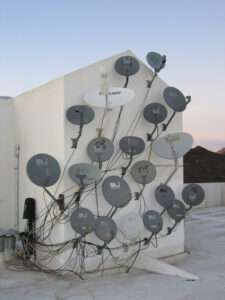How much do you depend on the technology that’s currently orbiting the Earth?
From simple day-to-day things such as using your car’s GPS or calling your family overseas, to work-related tasks such as accessing detailed imagery for ecological assessments, many things we often take for granted depend on space infrastructure. Our lives are so dependent on it that losing it would stop us in our tracks in nearly every aspect of our lives. The good news is that there’s a lot of work going into safeguarding this critical infrastructure – and TERN’s playing a role in it.
In just four years TERN has made significant investments in infrastructure and services to support the fields of remote sensing, earth observation, positioning, information technology, and communication networks. The infrastructure we provide enables environmental research around Australia, and throughout the world, to access a unique range of ecosystem data, including remotely sensed products and matching field survey data, energy and gas flux data, and vegetation and fauna survey data. These datasets, along with the standardised techniques used to produce them, are leading to new longer term and larger area analysis and modelling applications being built on TERN infrastructure.
In recognition of this investment and of the value of our collaborative infrastructure network and expertise, TERN was invited to contribute to the Attorney-General’s Department’s Critical Infrastructure Resilience program through the community of interest it is developing around space-related activities. Except in this case it is infrastructure in space used to examine the earth.
The project aims to ensure that essential everyday infrastructure is able to avoid disruptions that would affect a huge range of public and private services. Trusted Information Sharing Network (TISN) groups are working on seven key sectors including banking and finance, energy, health and food security.
TERN’s Science Director, Professor Stuart Phinn, is contributing to the creation of a new TISN group that’s working on ensuring the resilience of Australia’s space- and ground-based earth-observation infrastructure.
The group is reviewing the infrastructure and identifying the main risks to their disruption.
Critical infrastructure includes Global Positioning Systems (GPS), the constellations of satellites operated by a number of countries that enable us to record position; and satellite imaging systems, the satellites, sensors, ground-receiving and control stations, and data-processing facilities that deliver the data.
‘Both of these “systems” rely on infrastructure operated by other countries, although Australia has significant infrastructure for receiving, processing and using these data. Australian science is recognised as world leading in building applications with these data and for providing internationally unique calibration and validation capabilities,’ says Stuart.
From solar superstorm scenarios to simpler possibilities like parts breaking and needing to be fixed from time to time, the group will assess the possible risks prior to developing preventative solutions.
‘Interestingly, one of the biggest risks is if the data supply from either network is “turned off” by the country that provides it,’ says Stuart.
‘For GPS that means any position-measuring device will stop working, which would have wide-ranging impacts on everything from in-car navigation, aircraft and boats, to financial transactions that use the network for location and time.’
Such a scenario isn’t pure fantasy: it happened last year during the United States federal government shutdown when the US stopped distributing satellite imagery from several of its programs.
Other risks to the infrastructure include satellite and sensor failures. As this article suggests, just a single day without our earth-monitoring satellites could cause widespread chaos.
‘If we [Australia] were to lose access to Japan’s meteorological satellites, that would shut down most of the Bureau of Meteorology’s weather forecasting, including its ability to monitor and predict cyclones,’ warns Stuart.
Let alone the world’s transport, communications and business sectors. Without efforts to safeguard our critical research infrastructure you can forget about watching the World Cup, and on accessing our remotely sensed products. It’s reassuring to know that we have a team of experts ensuring their sustainability, and that TERN is playing a role.


We all rely on the technology that’s orbiting the Earth, some of us more than others. Safeguarding our critical environment and landscape research infrastructure ensures you don’t miss a minute of the World Cup and, more importantly, can continue to access detailed remotely sensed imagery for scientific studies from networks like TERN (Image courtesy Flickr redteam CC BY-NC-ND 2.0).
Published in TERN newsletter June 2014






